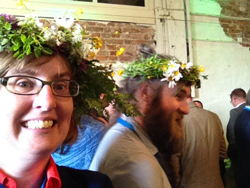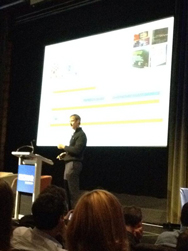Annie Pettit
For those who were able to tear themselves away from the medieval city of Stockholm with its cobblestone streets, amazing architecture, and delectable desserts (you really need to try Princess Cake!), the 2014 ESOMAR Digital Dimensions conference had much to chew on as well.
Personally, I’m a big fan of smaller conferences. I like finding and claiming for two whole days the ‘best’ seat which, of course, is  right next to multiple power bars, and has a good sight line to the speaker and the screen. Smaller conferences mean that over breaks and lunches, you pass by the same people a few times and through repeated chats, have a chance to really get to know someone, more than just remembering a name or a face. Of course, some faces, and beards, perhaps that of Gawain Morrison, the CEO of Sensum, are more memorable than others.
right next to multiple power bars, and has a good sight line to the speaker and the screen. Smaller conferences mean that over breaks and lunches, you pass by the same people a few times and through repeated chats, have a chance to really get to know someone, more than just remembering a name or a face. Of course, some faces, and beards, perhaps that of Gawain Morrison, the CEO of Sensum, are more memorable than others.

The presentation that intrigued me the most was given by Alex Johnson from Kantar. Entitled “What do Wearable Devices Bring to Market Research,” his presentation ignored all the hype and speculation and random ruminations about Google Glass and focused solely on its usability. Using pictures gathered by people shopping for new mobile phones, we were able to view and compare images collected by Google Glass with those collected by other types of cameras (e.g., Autographer which hangs around your neck) and eye tracking devices. The results clearly showed that Google Glass often failed to capture images of the products and their important details, including the branding and colouring. Apparently, people don’t always point their head and their eyes directly towards what they are looking at. Side glances, and up and down glances, mean that much of what the consumer pays attention to is missed. Speculation complete. Google Glass is nowhere near ready for use as a marketing research data collection tool. And by the way, as officially voted by the conference committee, and unofficially by me with a tweet, Alex won Best Paper of the event.

Also much loved by the audience, and generating the Best Presentation Award, was The Zero Moment of Memory talk by Nick Drew of Yahoo! and Olga Churkina of Fresh Intelligence Research. Their presentation illustrated how people are selective about their memories depending on whether they’re permitted to use a memory aid, in this case a mobile phone to take pictures. As expected, when people are allowed to use their memory aids, they outperform on recall compared to people who don’t have a memory aid. However, if you take away the memory aid, the tool that they had assigned to do the remembering for them, they perform more poorly than when they were not allowed to use a memory aid at all. What’s the moral of the story? Brands need to be very salient. They need to make people want to remember them. They need to make people remember them even if they don’t take a picture and don’t have their phone in front of them.
Above all, and across many of the presentations, what struck me the most is that marketing research is no longer the domain of traditional marketing researchers handing out surveys and moderating focus groups. It is no longer in ‘our’ hands. What we used to see as ‘our’ domain is no longer our domain. Well, actually it is. Anyone conducting marketing research, whether it’s understanding consumers better or markets better, and regardless of what research technique they use, is a marketing researcher.
For instance, in The People Side of Innovation, Stefan Lindegaard repeatedly reminded us, to the horror of any engineers who may have been in the room, that research innovation is no longer in the hands of engineers. Innovation is in YOUR hands, whether you are a survey programmer, survey logic tester, project manager, or sales director, client service rep, or in PR. As marketing researchers, we can’t continue to watch with fear or disappointment as start-up companies turn decidedly non-marketing research tools, like visual or skin or brain or electrical sensors into marketing research tools. We need to step up and do the research that we envy in others.
If you can call surveys a tradition in our industry, a few presentations did pay homage to traditional research. But, surveys (no one talked about focus groups) were always the secondary topic. We saw examples of using text analytics, normally a social media tool, to take advantage of the breadth and depth of survey verbatims such that overly lengthy surveys could be much shorter and more engaging (Alexander Wheatley, GMI). We also saw examples of using geocoded mobile surveys to determine the perfect moment, not a minute too soon nor too late, to present a mobile survey to a consumer who is mid-shopping trip (Carsten Andreasen, Google, Denmark; Johanna Fyrbjörk, Ipsos)
 Finally, of course, no conference is complete without experiencing the local culture. After a lovely boat ride around Södermalm, one of the districts in central Stockholm, passing by colorful 18th century buildings, and under numerous bridges and locks, we arrived at Skyddsrummet. This old brewery was the perfect setting for a traditional Swedish meal, including pickled herring, numerous rounds of Schnapps, as well as singing and dancing to celebrate the traditional Swedish Midsummer Festival. And those who wished to spruce themselves up for the evening were provided with all the materials to craft their own Midsummer head wreath. I suspect, however, that some people, perhaps Pravin Shekar, benefited from the years of wreath building experience that our kind Swedish hosts have.
Finally, of course, no conference is complete without experiencing the local culture. After a lovely boat ride around Södermalm, one of the districts in central Stockholm, passing by colorful 18th century buildings, and under numerous bridges and locks, we arrived at Skyddsrummet. This old brewery was the perfect setting for a traditional Swedish meal, including pickled herring, numerous rounds of Schnapps, as well as singing and dancing to celebrate the traditional Swedish Midsummer Festival. And those who wished to spruce themselves up for the evening were provided with all the materials to craft their own Midsummer head wreath. I suspect, however, that some people, perhaps Pravin Shekar, benefited from the years of wreath building experience that our kind Swedish hosts have.
And now, to Nice!


